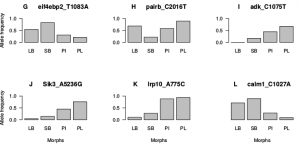Extensive genetic divergence between recently evolved sympatric Arctic charr morphs
The availability of diverse ecological niches can promote adaptation of trophic specializations and related traits, as has been repeatedly observed in evolutionary radiations of freshwater fish. The role of genetics, environment and history in ecologically driven divergence and adaptation, can be studied on adaptive radiations or populations showing ecological polymorphism. Salmonids, especially the Salvelinus genus that includes Arctic charr (Salvelinus alpinus), are renowned for both phenotypic diversity and polymorphism. Arctic charr invaded Icelandic streams during the glacial retreat (about 9,000 to 12,000 years ago) and exhibits many instances of sympatric polymorphism. Particularly well studied are the four morphs in Lake Þingvallavatn in Iceland. The small benthic (SB), large benthic (LB), planktivorous (PL) and piscivorous (PI) charr differ in many regards, including size, form and life history traits. To investigate relatedness and genomic differentiation between morphs we extracted variants from developmental transcriptome data from three of those morphs, and verified 22 variants in population samples. The data reveal genetic differences between the morphs, with the two benthic morphs being more similar and the PL-charr more genetically different. The markers with high differentiation map to all linkage groups, suggesting ancient and pervasive genetic separation of these three morphs. No marker associated fully with morph, suggesting polygenic basis of traits separating them. Furthermore, gene ontology analyses suggest differences in collagen metabolism, odontogenesis and sensory systems between PL-charr and the benthic morphs. Genotyping in population samples from all four morphs confirms the genetic separation and indicates that the PI-charr are less genetically distinct than the other three morphs. The genetic separation of the other three morphs indicates certain degree of reproductive isolation. The extent of gene flow between the morphs and the nature of reproductive barriers between them remain to be elucidated.
One of the preliminary data for the paper, several markers differentiate the four morphs.
